The Application of a Fluoride-and-Vitamin D Solution to Deciduous Teeth Promotes Formation of Persistent Mineral Crystals: A Morphological Ex-Vivo Study
Abstract
1. Introduction
2. Materials and Methods
2.1. Samples Selection and Cutting Procedure
2.2. Experimental Design
2.3. Sample Preparation for Variable Pressure Scanning Electron Microscope (VP–SEM)
2.4. 3D Reconstruction and Surface Analysis Procedure
2.5. Statistical Analysis
3. Results
4. Discussion
5. Conclusions
Author Contributions
Funding
Institutional Review Board Statement
Informed Consent Statement
Data Availability Statement
Conflicts of Interest
References
- US Department of Health and Human Services, National Institute of Dental and Craniofacial Research, National Institutes of Health. Oral Health in America: A Report of the Surgeon General; U.S. Department of Health and Human Services, National Institute of Dental and Craniofacial Research, National Institutes of Health. Rockville, MD, USA. 2000. Available online: https://www.nidcr.nih.gov/sites/default/files/2017-10/hck1ocv.%40www.surgeon.fullrpt.pdf (accessed on 22 April 2023).
- Smaïl-Faugeron, V.; Porot, A.; Muller-Bolla, M.; Courson, F. Indirect pulp capping versus pulpotomy for treating deep carious lesions approaching the pulp in primary teeth: A systematic review. Eur. J. Paediatr. Dent. 2016, 17, 107–112. [Google Scholar] [PubMed]
- Global Burden of Disease Collaborative Network. Global Burden of Disease Study 2019 (GBD 2019); Institute of Health Metrics and Evaluation (IHME): Seattle, WA, USA, 2020; Available online: http://ghdx.healthdata.org/gbd-results-tool (accessed on 22 April 2023).
- Selwitz, R.H.; Ismail, A.I.; Pitts, N.B. Dental caries. Lancet 2007, 369, 51–59. [Google Scholar] [CrossRef]
- American Academy of Pediatric Dentistry; American Academy of Pediatrics. Policy on early childhood caries (ECC): Classifications, consequences, and preventive strategies. Pediatr. Dent. 2008, 30, 40–43. [Google Scholar]
- De Menezes Oliveira, M.A.; Torres, C.P.; Gomes-Silva, J.M.; Chinelatti, M.A.; De Menezes, F.C.; Palma-Dibb, R.G.; Borsatto, M.C. Microstructure and Mineral Composition of Dental Enamel of Permanent and Deciduous Teeth. Microsc. Res. Tech. 2010, 73, 572–577. [Google Scholar] [CrossRef] [PubMed]
- Walsh, T.; Worthington, H.V.; Glenny, A.M.; Marinho, V.C.; Jeroncic, A. Fluoride toothpastes of different concentrations for preventing dental caries. Cochrane Database Syst. Rev. 2019, 3, CD007868. [Google Scholar] [CrossRef]
- Aulestia, F.J.; Groeling, J.; Bomfim, G.H.S.; Costiniti, V.; Manikandan, V.; Chaloemtoem, A.; Concepcion, A.R.; Li, Y.; Wagner, L.E., 2nd; Idaghdour, Y.; et al. Fluoride exposure alters Ca2+ signaling and mitochondrial function in enamel cells. Sci. Signal 2020, 13, eaay0086. [Google Scholar] [CrossRef]
- Bossù, M.; Saccucci, M.; Salucci, A.; Di Giorgio, G.; Bruni, E.; Uccelletti, D.; Sarto, M.S.; Familiari, G.; Relucenti, M.; Polimeni, A. Enamel Remineralization and Repair Results of Biomimetic Hydroxyapatite Toothpaste on Deciduous Teeth: An Effective Option to Fluoride Toothpaste. J. Nanobiotechnol. 2019, 17, 17. [Google Scholar] [CrossRef]
- Bossù, M.; Matassa, R.; Relucenti, M.; Iaculli, F.; Salucci, A.; Di Giorgio, G.; Familiari, G.; Polimeni, A.; Di Carlo, S. Morpho-Chemical Observations of Human Deciduous Teeth Enamel in Response to Biomimetic Toothpastes Treatment. Materials 2020, 13, 1803. [Google Scholar] [CrossRef]
- Gyll, J.; Ridell, K.; Öhlund, I.; Åkeson, P.K.; Johansson, I.; Lif Holgerson, P. Vitamin D status and dental caries in healthy Swedish children. Nutr. J. 2018, 17, 11. [Google Scholar] [CrossRef]
- Berdal, A.; Papagerakis, P.; Hotton, D.; Bailleul-Forestier, I.; Davideau, J.L. Ameloblasts and odontoblasts, target-cells for 1,25-dihydroxyvitamin D3: A review. Int. J. Dev. Biol. 1995, 39, 257–262. [Google Scholar]
- Hujoel, P.P. Vitamin D and dental caries in controlled clinical trials: Systematic review and meta-analysis. Nutr. Rev. 2013, 71, 88–97. [Google Scholar] [CrossRef] [PubMed]
- Chhonkar, A.; Gupta, A.; Arya, V. Comparison of Vitamin D Level of Children with Severe Early Childhood Caries and Children with No Caries. Int. J. Clin. Pediatr. Dent. 2018, 11, 199–204. [Google Scholar] [CrossRef]
- Al-Jubori, S.; AL-Murad, M.A.; Al-Mashhadane, F. Effect of Oral Vitamin D3 on Dental Caries: An In-Vivo and In-Vitro Study. Cureus 2022, 14, e25360. [Google Scholar] [CrossRef] [PubMed]
- Kühnisch, J.; Thiering, E.; Heinrich-Weltzien, R.; Hellwig, E.; Hickel, R.; Heinrich, J. Fluoride/vitamin D tablet supplementation in infants-effects on dental health after 10 years. Clin. Oral Investig. 2017, 21, 2283–2290. [Google Scholar] [CrossRef] [PubMed]
- Donfrancesco, O.; Del Giudice, A.; Zanza, A.; Relucenti, M.; Petracchiola, S.; Gambarini, G.; Testarelli, L.; Seracchiani, M. SEM Evaluation of Endosequence BC Sealer Hiflow in Different Environmental Conditions. J. Compos. Sci. 2021, 5, 99. [Google Scholar] [CrossRef]
- Relucenti, M.; Miglietta, S.; Bove, G.; Donfrancesco, O.; Battaglione, E.; Familiari, P.; Barbaranelli, C.; Covelli, E.; Barbara, M.; Familiari, G. SEM BSE 3D Image Analysis of Human Incus Bone Affected by Cholesteatoma Ascribes to Osteoclasts the Bone Erosion and VpSEM dEDX Analysis Reveals New Bone Formation. Scanning 2020, 2020, 9371516. [Google Scholar] [CrossRef]
- Fichera, G.; Santonocito, S.; Ronsivalle, V.; Polizzi, A.; Torrisi, S.; Deodato, L.; Palazzo, G.; Isola, G. Prevalence of Early Childhood Caries in Southern Italy: An Epidemiological Study. Int. J. Dent. 2021, 2021, 5106473. [Google Scholar] [CrossRef]
- Kirthiga, M.; Murugan, M.; Saikia, A.; Kirubakaran, R. Risk factors for early childhood caries: A systematic review and meta-analysis of case control and cohort studies. Pediatr. Dent. 2019, 41, 95–112. [Google Scholar]
- Carta, G.; Cagetti, M.G.; Sale, S.; Congiu, G.; Strohmenger, L.; Oleari, F.; Bossù, M.; Lingström, P.; Campus, G.; Italian Experimental Group on Oral Health. Oral health inequalities in Italian schoolchildren—A cross-sectional evaluation. Community Dent. Health 2014, 31, 123–128. [Google Scholar]
- Pakkhesal, M.; Riyahi, E.; Naghavi Alhosseini, A.; Amdjadi, P.; Behnampour, N. Impact of dental caries on oral health related quality of life among preschool children: Perceptions of parents. BMC Oral Health 2021, 21, 68. [Google Scholar] [CrossRef]
- Lalumandier, J.A.; Rozier, R.G. The Prevalence and Risk Factors of Fluorosis among Patients in a Pediatric Dental Practice. Pediatr. Dent. 1995, 17, 19–25. [Google Scholar] [PubMed]
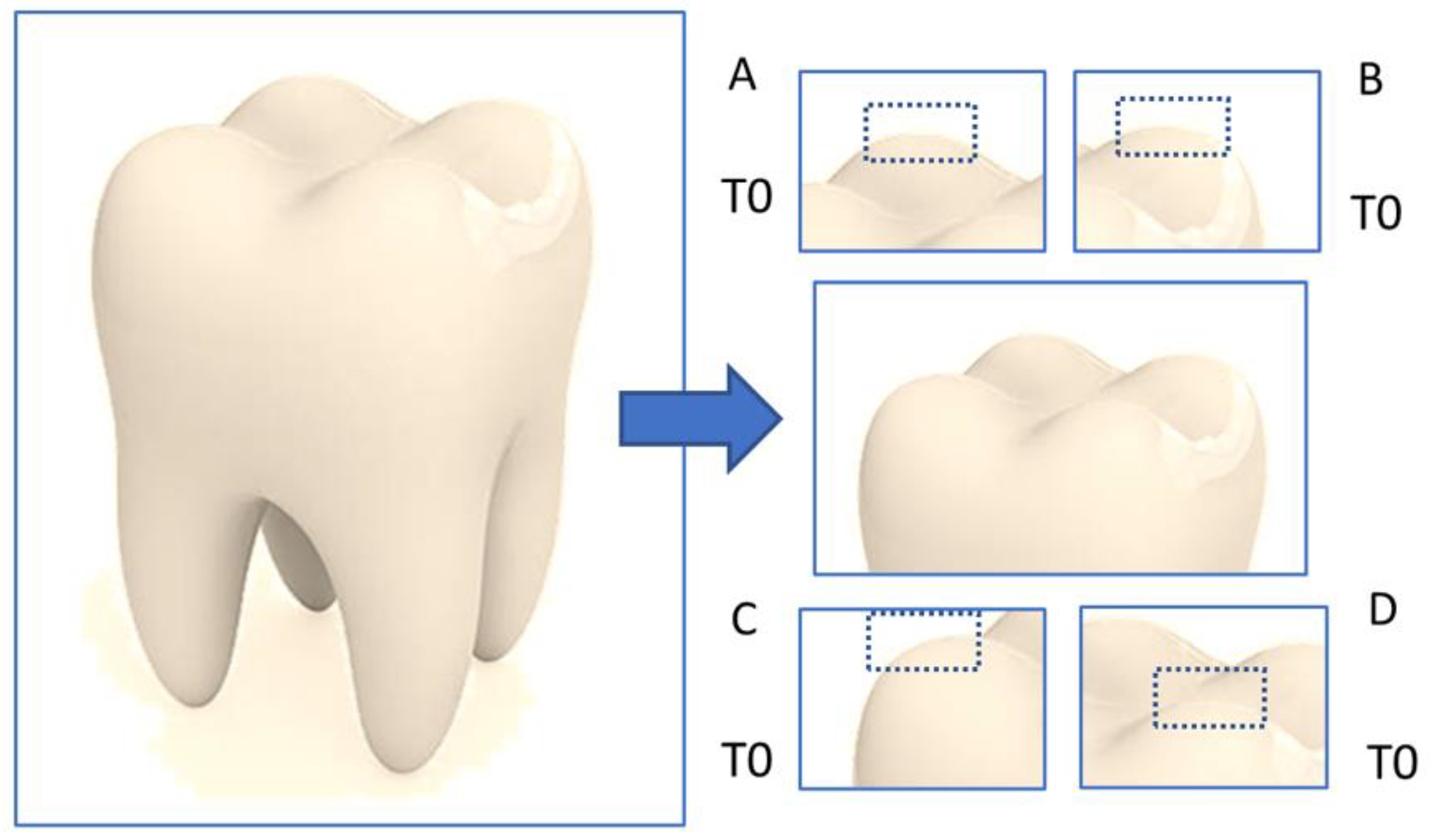
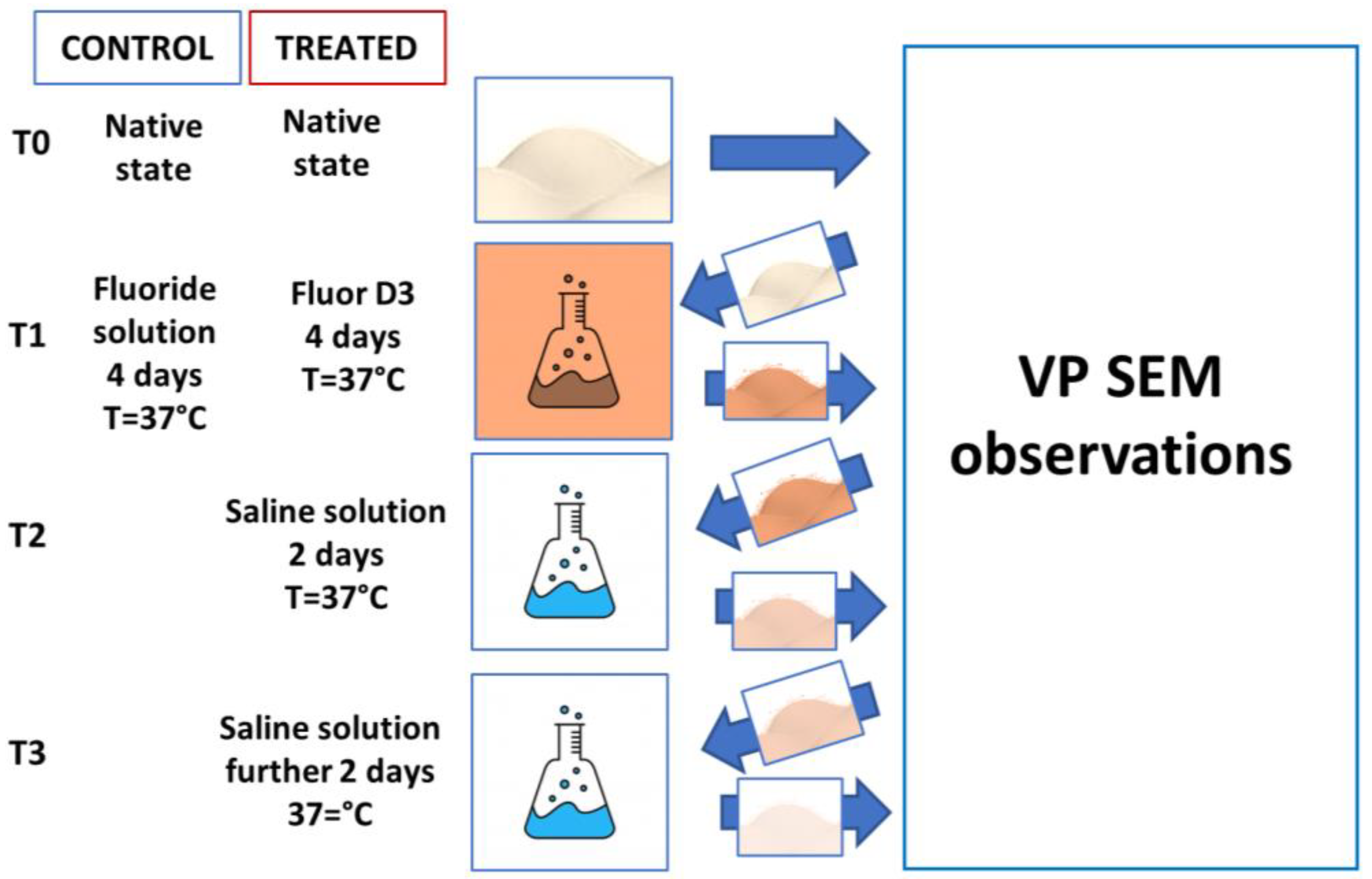
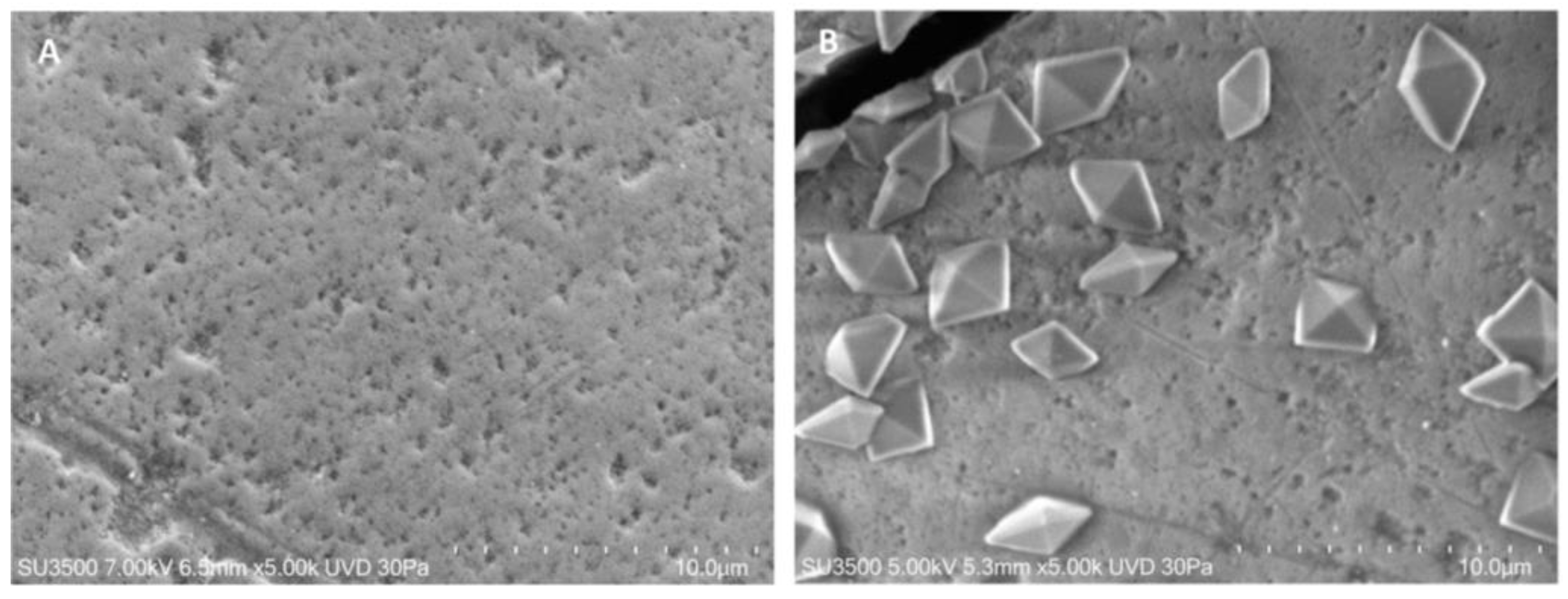

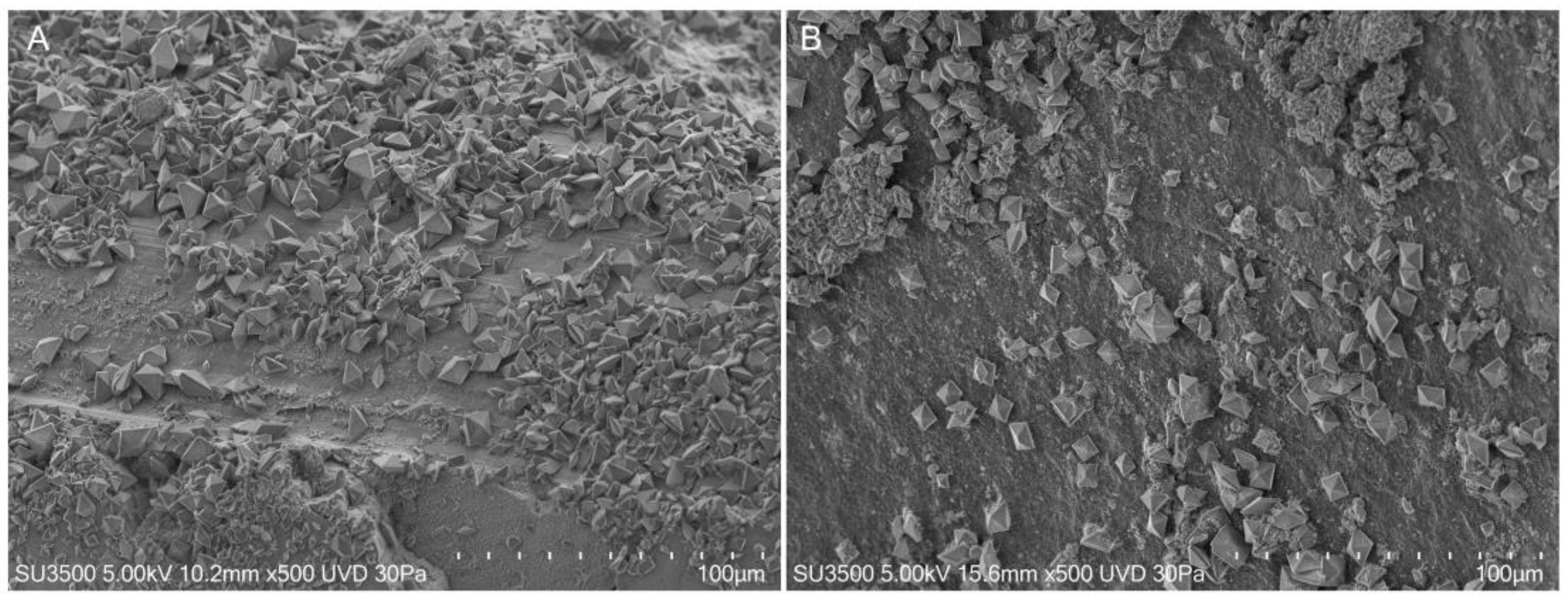


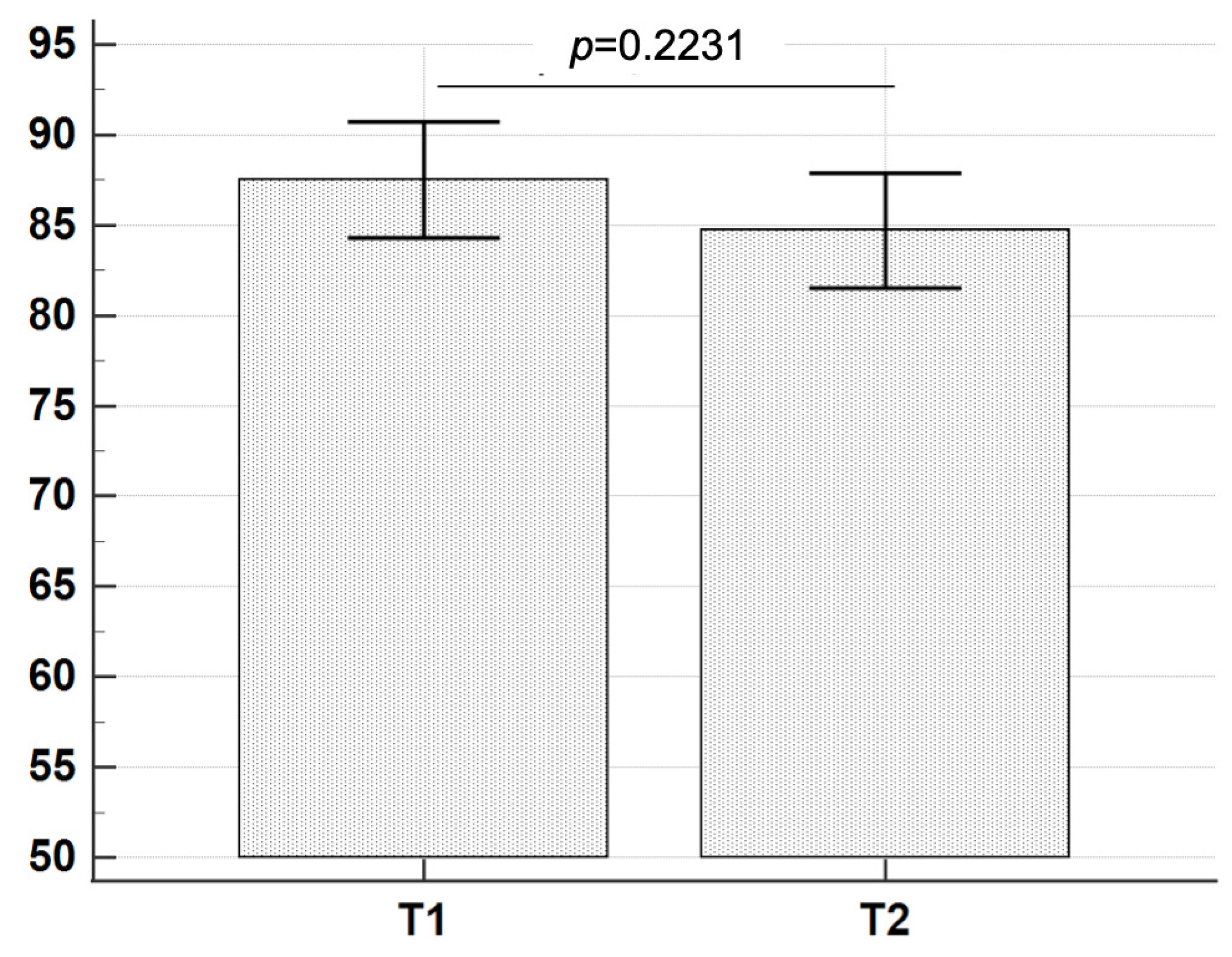
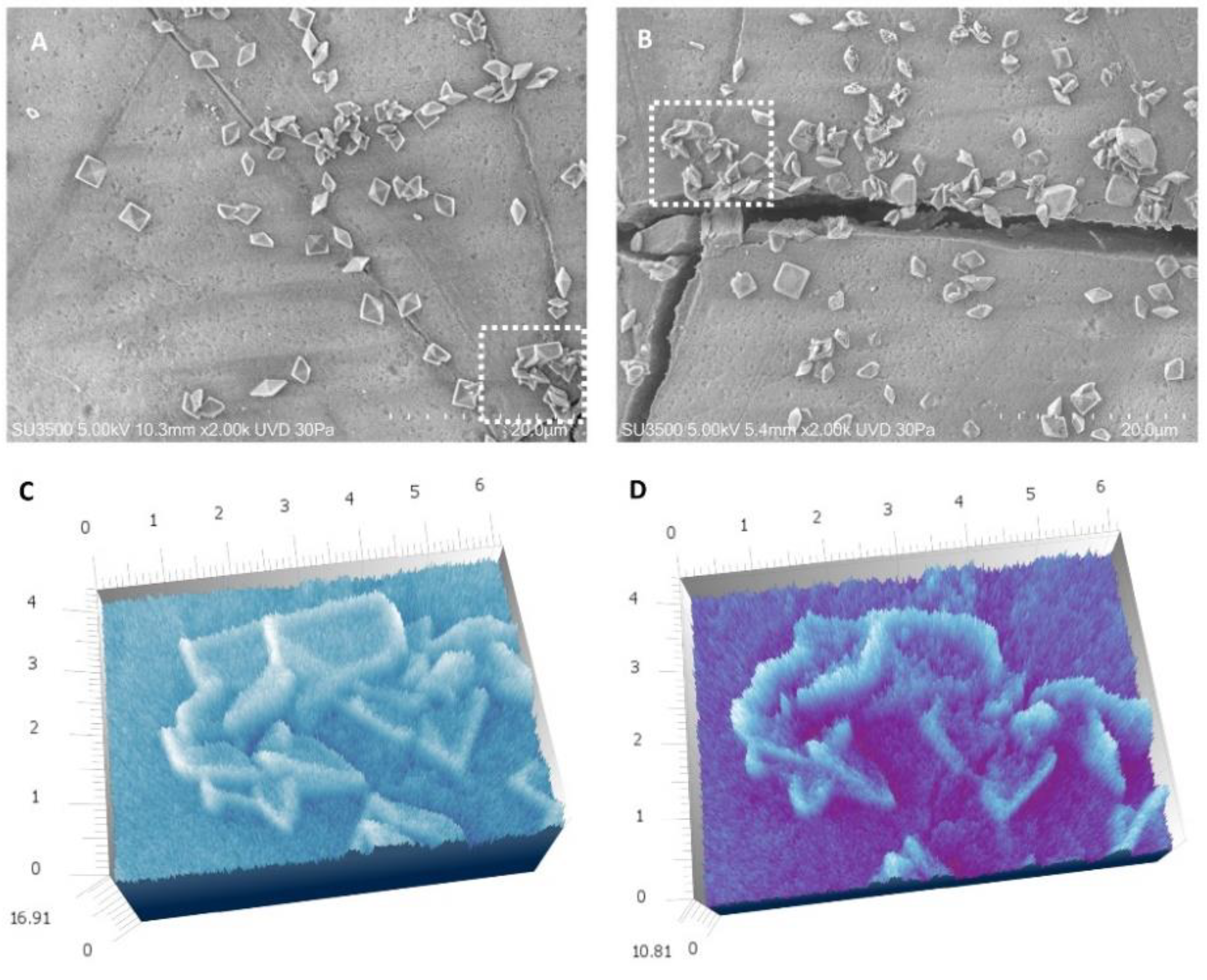
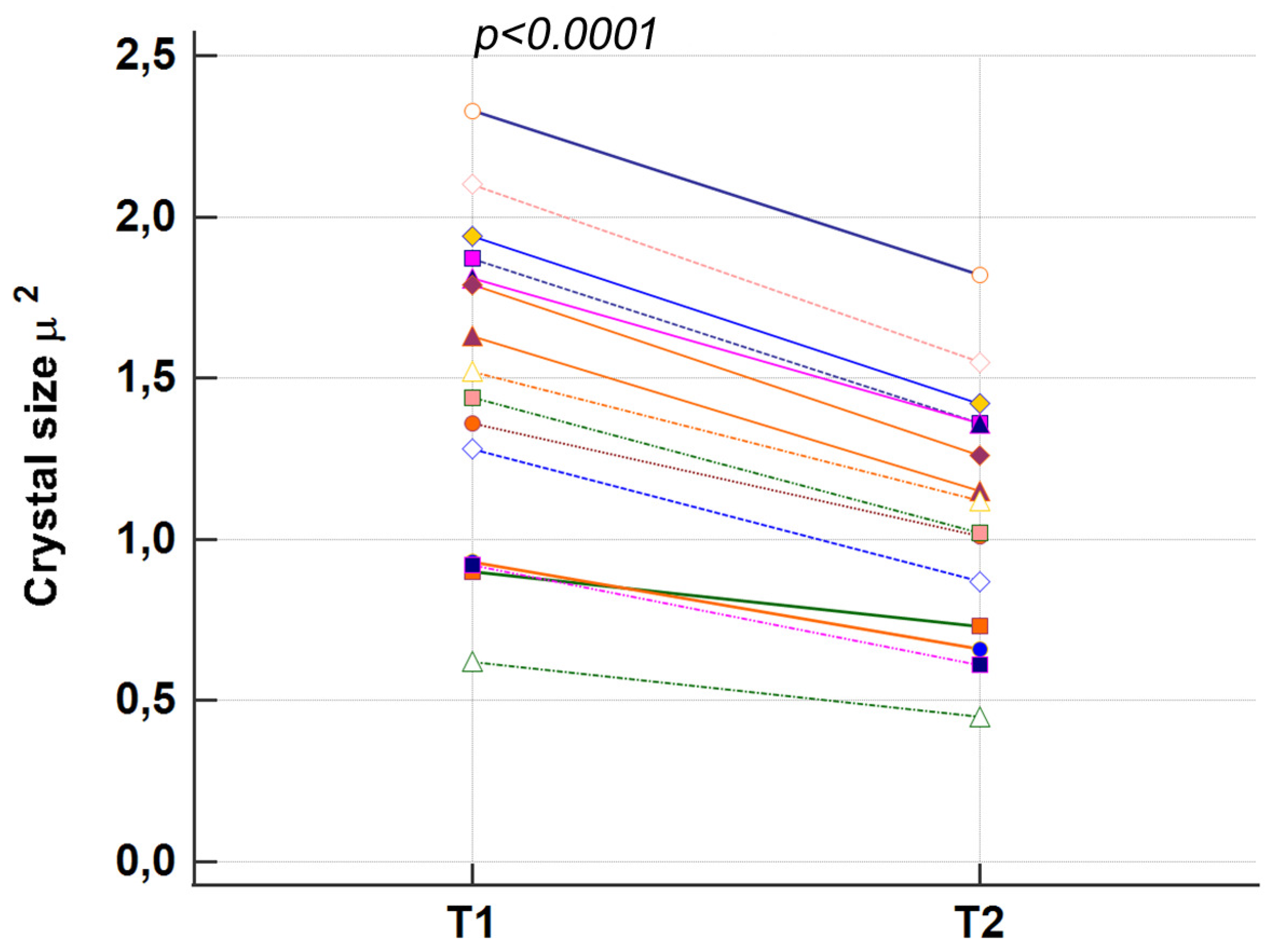
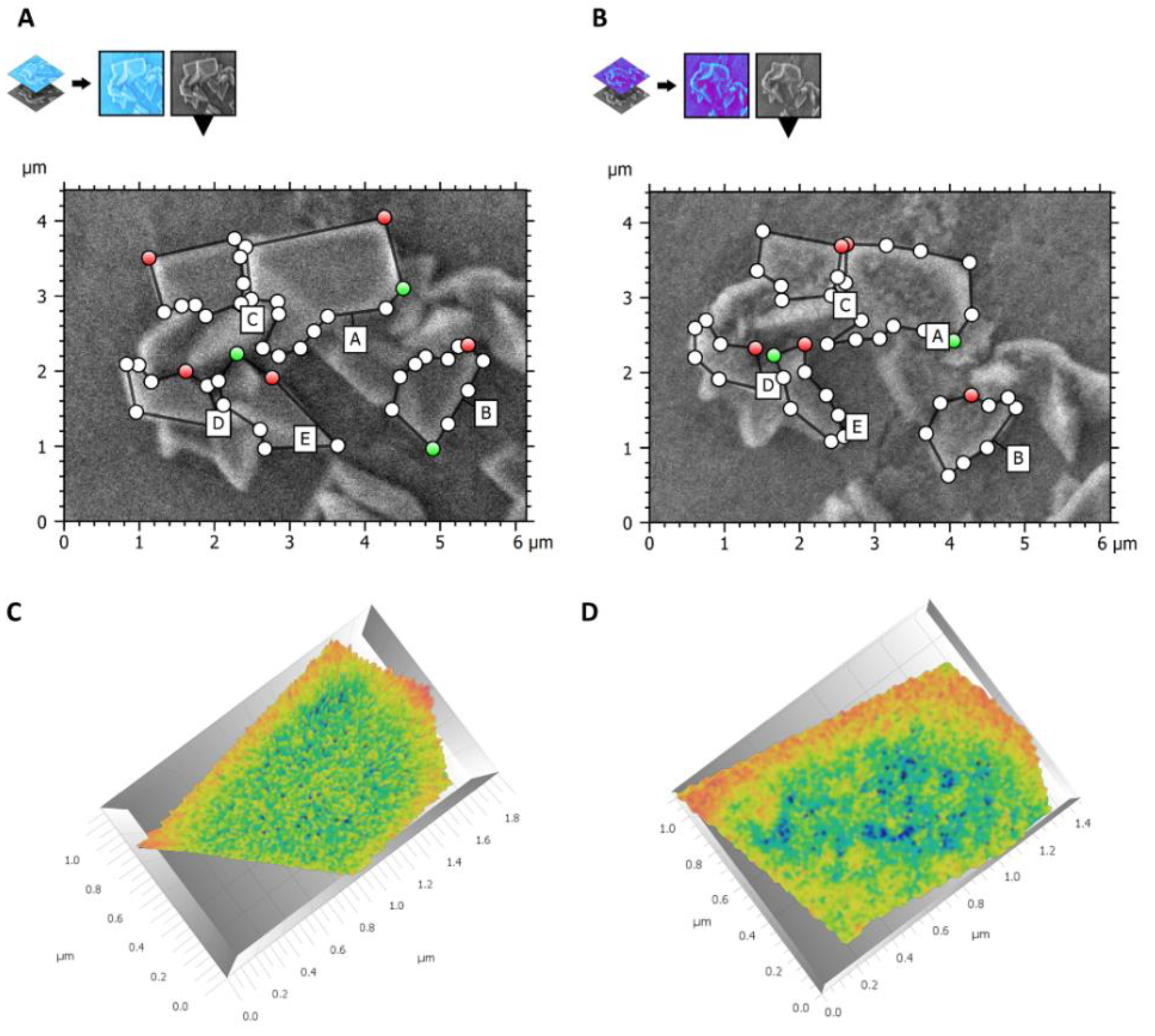
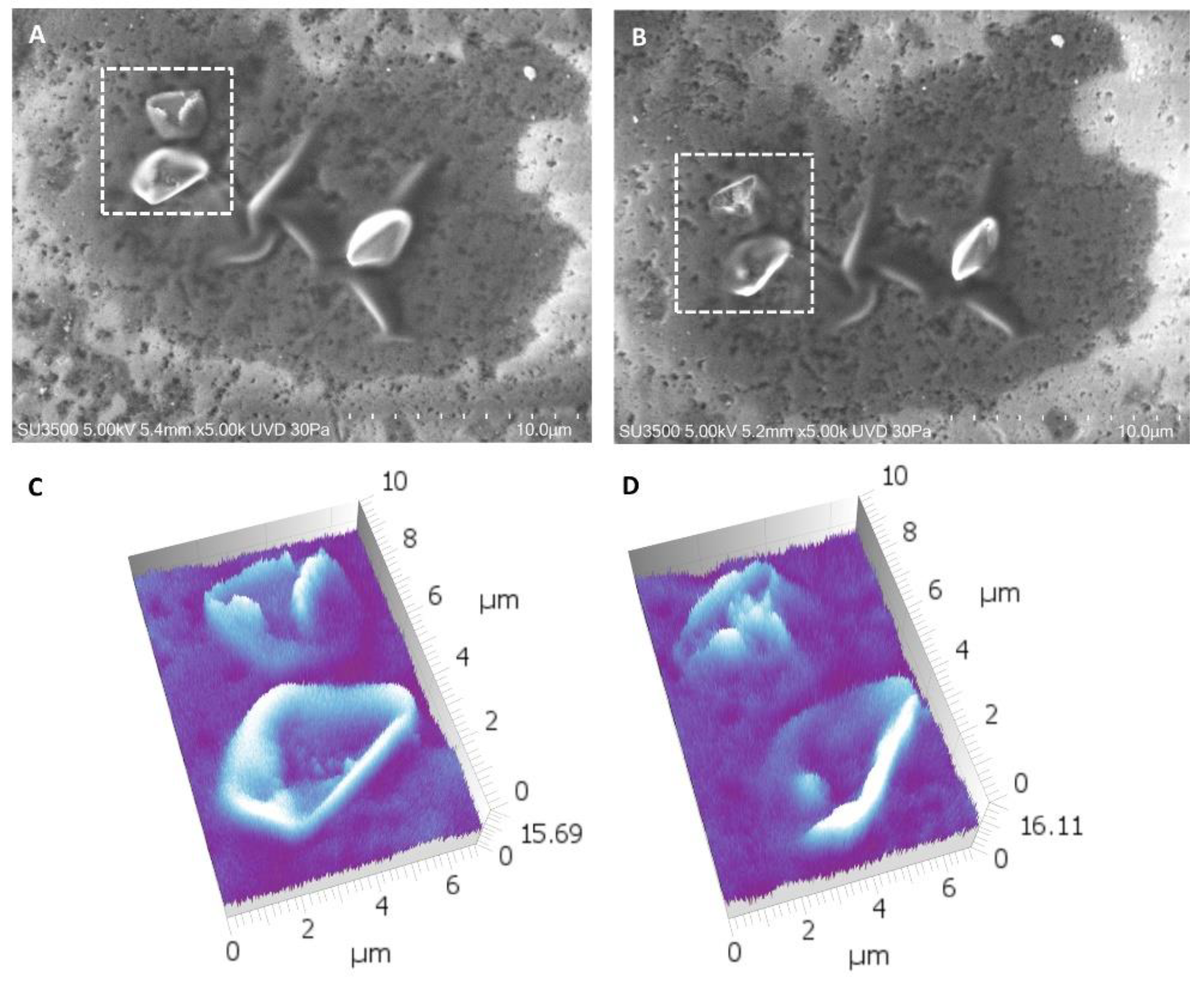
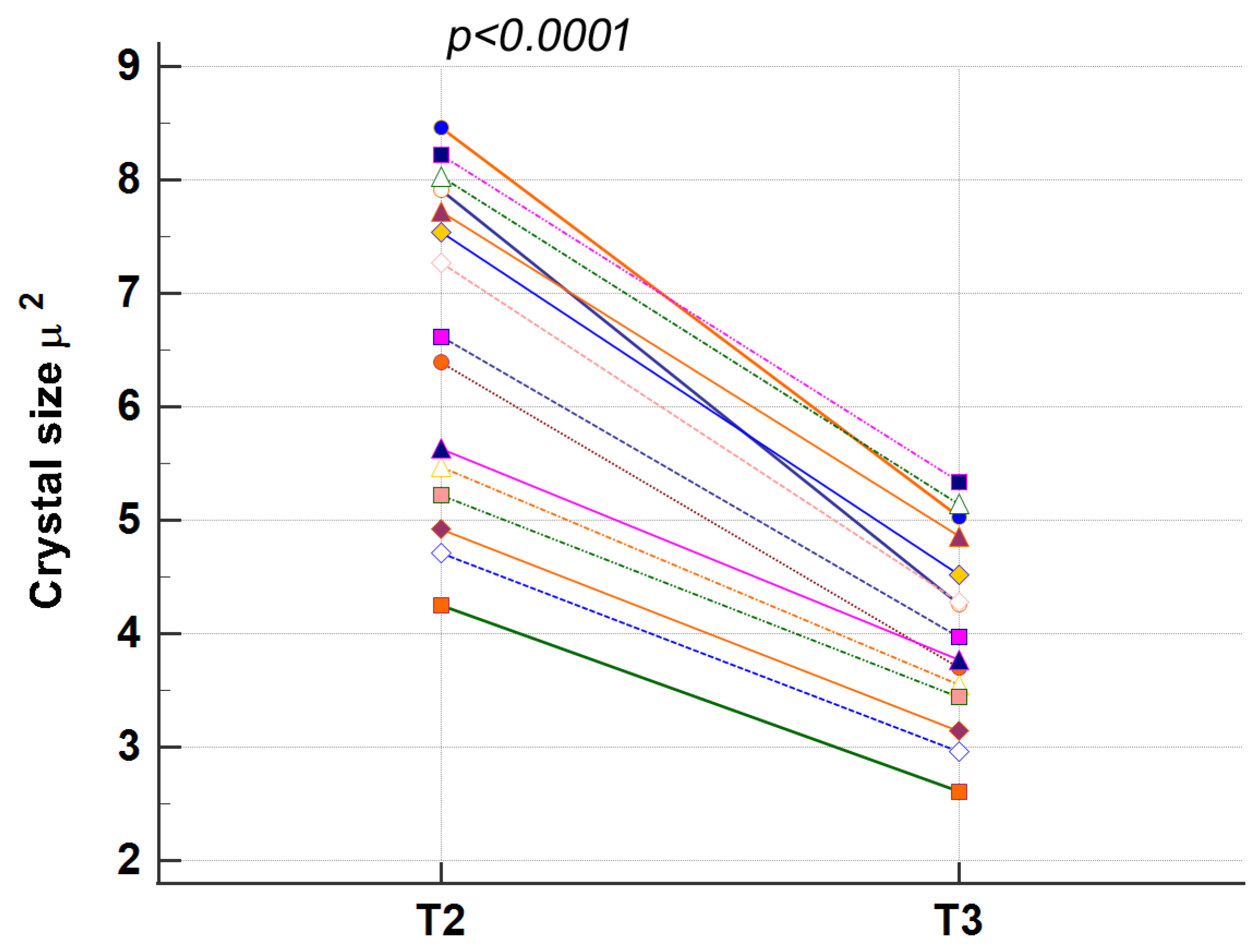

| Fluoride Solution | FluorD3 | |
|---|---|---|
| Sample size | 105 | 105 |
| Arithmetic mean | 85.85 | 87.50 |
| 95% CI mean | 82.74–88.96 | 84.28–90.72 |
| Variance | 257.95 | 277.21 |
| Standard deviation | 16.06 | 16.64 |
| Standard error of the mean | 1.56 | 1.62 |
| Fluoride | FluorD3 | |
|---|---|---|
| Sample size | 150 | 150 |
| Arithmetic mean | 1.49 | 1.54 |
| 95% CI mean | 1.44–1.54 | 1.49–1.59 |
| Variance | 0.1 | 0.11 |
| Standard deviation | 0.31 | 0.32 |
| Standard error of the mean | 0.02 | 0.03 |
| T1 | T2 | |
|---|---|---|
| Sample size | 105 | 105 |
| Arithmetic mean | 87.50 | 84.71 |
| 95% CI mean | 84.28–90.72 | 81.53–87.89 |
| Variance | 277.21 | 270 |
| Standard deviation | 16.64 | 16.44 |
| Standard error of the mean | 1.62 | 1.60 |
| T1 | T2 | |
|---|---|---|
| Sample size | 15 | 15 |
| Arithmetic mean | 1.49 | 1.09 |
| 95% CI mean | 1.22–1.77 | 0.88–1.30 |
| Variance | 0.24 | 0.14 |
| Standard deviation | 0.496 | 0.38 |
| Standard error of the mean | 0.12 | 0.09 |
| T2 | T3 | |
|---|---|---|
| Sample size | 15 | 15 |
| Arithmetic mean | 6.55 | 4.03 |
| 95% CI mean | 5.76–7.34 | 3.57–4.49 |
| Variance | 2.03 | 0.69 |
| Standard deviation | 1.42 | 0.83 |
| Standard error of the mean | 0.36 | 0.21 |
Disclaimer/Publisher’s Note: The statements, opinions and data contained in all publications are solely those of the individual author(s) and contributor(s) and not of MDPI and/or the editor(s). MDPI and/or the editor(s) disclaim responsibility for any injury to people or property resulting from any ideas, methods, instructions or products referred to in the content. |
© 2023 by the authors. Licensee MDPI, Basel, Switzerland. This article is an open access article distributed under the terms and conditions of the Creative Commons Attribution (CC BY) license (https://creativecommons.org/licenses/by/4.0/).
Share and Cite
Di Giorgio, G.; Relucenti, M.; Iaculli, F.; Salucci, A.; Donfrancesco, O.; Polimeni, A.; Bossù, M. The Application of a Fluoride-and-Vitamin D Solution to Deciduous Teeth Promotes Formation of Persistent Mineral Crystals: A Morphological Ex-Vivo Study. Materials 2023, 16, 4049. https://doi.org/10.3390/ma16114049
Di Giorgio G, Relucenti M, Iaculli F, Salucci A, Donfrancesco O, Polimeni A, Bossù M. The Application of a Fluoride-and-Vitamin D Solution to Deciduous Teeth Promotes Formation of Persistent Mineral Crystals: A Morphological Ex-Vivo Study. Materials. 2023; 16(11):4049. https://doi.org/10.3390/ma16114049
Chicago/Turabian StyleDi Giorgio, Gianni, Michela Relucenti, Flavia Iaculli, Alessandro Salucci, Orlando Donfrancesco, Antonella Polimeni, and Maurizio Bossù. 2023. "The Application of a Fluoride-and-Vitamin D Solution to Deciduous Teeth Promotes Formation of Persistent Mineral Crystals: A Morphological Ex-Vivo Study" Materials 16, no. 11: 4049. https://doi.org/10.3390/ma16114049
APA StyleDi Giorgio, G., Relucenti, M., Iaculli, F., Salucci, A., Donfrancesco, O., Polimeni, A., & Bossù, M. (2023). The Application of a Fluoride-and-Vitamin D Solution to Deciduous Teeth Promotes Formation of Persistent Mineral Crystals: A Morphological Ex-Vivo Study. Materials, 16(11), 4049. https://doi.org/10.3390/ma16114049











